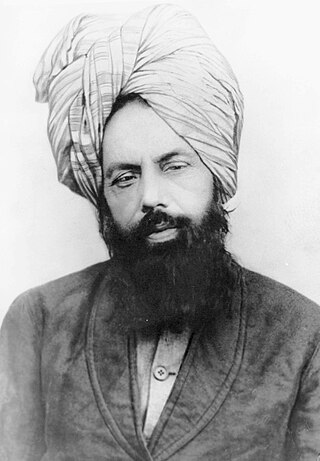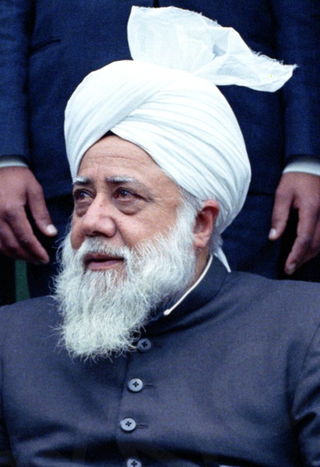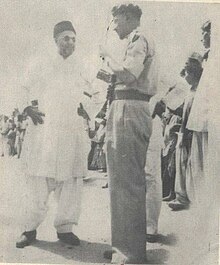Rabwah, officially known as Chenab Nagar, is a city in Chiniot, Punjab, Pakistan on the bank of Chenab River. It was the headquarters of the Ahmadiyya Muslim Community from September 20, 1948 when the community relocated from Qadian, India to the newly created state of Pakistan, where the community leased the area of present-day Rabwah from the government to establish its home. This continued until 1984 and the establishment of Ordinance XX. In 1984, the headquarters were moved to the United Kingdom with Mirza Tahir Ahmed, first to London and then in 2019 to the Islamabad compound in Tilford, Surrey.

Mirza Ghulam Ahmad was an Indian religious leader and the founder of the Ahmadiyya movement in Islam. He claimed to have been divinely appointed as the promised Messiah and Mahdī—which is the metaphorical second-coming of Jesus (mathīl-iʿIsā), in fulfillment of the Islamic prophecies regarding the end times, as well as the Mujaddid of the 14th Islamic century.

Sir Chaudhry Muhammad Zafarullah Khan was a Pakistani jurist and diplomat who served as the first Foreign Minister of Pakistan. After serving as foreign minister he continued his international career and is the only Pakistani to preside over the International Court of Justice. He also served as the President of the UN General Assembly. He is the only person to date to serve as the President of both UN General Assembly and the International Court of Justice.

The Dominion of Pakistan, officially Pakistan, was an independent federal dominion in the British Commonwealth of Nations, existing between 14 August 1947 and 23 March 1956, created by the passing of the Indian Independence Act 1947 by the British parliament, which also created an independent Dominion of India.

Syed Ata Ullah Shah Bukhari, was a Muslim Hanafi scholar, religious and political leader from the Indian subcontinent. He was one of the Majlis-e-Ahrar-e-Islam's founding members. His biographer, Agha Shorish Kashmiri, states that Bukhari's greatest contribution had been his germination of strong anti-British feelings among the Indian Muslims. He is one of the most notable leaders of the Ahrar movement which was associated with opposition to Muhammad Ali Jinnah and opposition to the establishment of an independent Pakistan, as well as opposition to the Ahmadiyya Movement. He is considered as a legendary rhetoric, which made him famous among the Muslims.
On 19 June 1953 a Court of Inquiry was established to look into disturbances in the Punjab, Pakistan caused by agitation against the Ahmadiyya minority group. The disturbances prompted Martial law to be declared and dozens were killed by the military in the process of their quelling. The inquiry into the disturbances commenced on 1 July 1953. Evidence was concluded on 23 January 1954 and arguments on 28 February 1954. The report was issued 10 April 1954. The inquiry was headed by Chief Justice Muhammad Munir and its report is commonly referred to as the "Munir Report", or "Munir-Kiyani report".

Mirza Nasir Ahmad was the third Caliph of the Ahmadiyya Muslim Community from Pakistan. He was elected as the third successor of Mirza Ghulam Ahmad on 8 November 1965, the day after the death of his predecessor and father, Mirza Basheer-ud-Din Mahmood Ahmad.

Mirza Basheer-ud-Din Mahmood Ahmad was the second caliph, leader of the worldwide Ahmadiyya Muslim Community and the eldest son of Mirza Ghulam Ahmad from his second wife, Nusrat Jahan Begum. He was elected as the second successor of Mirza Ghulam Ahmad on 14 March 1914 at the age of 25, the day after the death of his predecessor Hakim Nur-ud-Din.

The Fazl Mosque also known as The London Mosque, is the first purpose-built mosque in London, England. It was opened on 23 October 1926 in Southfields, Wandsworth. At a cost of £6,223, the construction of the mosque and the purchase of the land on which it stands, was financed by the donations of Ahmadi Muslim women in Qadian, Punjab, British India, with support from the British Muslim convert Khalid Sheldrake. Between 1984 and 2019 the Fazl Mosque was the residence of the caliphs of the Ahmadiyya Muslim Community, and therefore its de facto international headquarters. The administrative headquarters now lies at the site of the Islamabad, Tilford.

Mirza Masroor Ahmad is the current and fifth leader of the Ahmadiyya Muslim Community. His official title within the movement is Fifth Caliph of the Messiah. He was elected on 22 April 2003, three days after the death of his predecessor Mirza Tahir Ahmad.

In Ahmadiyya Islam, Jihad is a radical concept. It is primarily one's personal inner and outer struggle for self-purification. Armed struggle or military exertion is only to be used in defense. However, even then it can only be carried out under the direct instruction of a Caliph, purely for the sake of God and the preservation of religion. It is not permissible that jihad be used to spread Islam violently or for political motives, or that it be waged against a government that maintains religious freedom. Political conflicts over independence, land and resources or reasons other than religious belief cannot be termed jihad. There is a clear distinction, in Ahmadi theology, between Jihad (striving) and qitāl or jihad bil-saif (fighting). While Jihad may involve fighting, not all fighting can be called Jihad. Rather, according to Ahmadiyya belief, qitāl or military jihad is applicable, only as a defensive measure in very strictly defined circumstances and those circumstances do not exist at present.

The Ahmadiyya branch of Islam has been subjected to various forms of religious persecution and discrimination since the movement's inception in 1889. The Ahmadiyya Muslim movement emerged within the Sunni tradition of Islam and its adherents believe in all of the five pillars and all of the articles of faith required of Muslims. Ahmadis are considered non-Muslims by many mainstream Muslims since they consider Mirza Ghulam Ahmad, the founder of the movement, to be the promised Mahdi and Messiah awaited by the Muslims.

Ahmadiyya, officially the Ahmadiyya Muslim Jama'at (AMJ) is an Islamic messianic movement originating in British India in the late 19th century. It was founded by Mirza Ghulam Ahmad (1835–1908), who said he had been divinely appointed as both the Promised Mahdi and Messiah expected by Muslims to appear towards the end times and bring about, by peaceful means, the final triumph of Islam; as well as to embody, in this capacity, the expected eschatological figure of other major religious traditions. Adherents of the Ahmadiyya—a term adopted expressly in reference to Muhammad's alternative name Aḥmad—are known as Ahmadi Muslims or simply Ahmadis.

The 1953 Lahore riots were a series of violent riots against the Ahmadiyya movement, a faith marginalized in Pakistan, mainly in the city of Lahore, as well as the rest of Punjab, which were eventually quelled by the Pakistan Army who declared three months of martial law. The demonstrations began in February 1953, soon escalating into citywide incidents, including looting, arson and the murder of somewhere between 200 and 2000 people. Thousands more were left displaced. According to the official inquiry conducted by the Punjab Government, the actual number killed in these riots was around 20. The first page of the inquiry says that before the declaration of martial law, the police killed two people on the night of 4th March and ten the 5th. 66 people were admitted to Lahore hospitals with gunshot wounds. The military attempting to quell the disturbances in Lahore admitted to killing 11 and wounding 49. There were additional casualties in other towns. Seeing that police were unable to contain the increasingly widespread unrest, Governor-General Malik Ghulam Muhammad handed over the administration of the city to the army under Lieutenant General Azam Khan, imposing martial law on 6 March.

The May 2010 Lahore attacks, also referred to as the Lahore massacre, occurred on 28 May 2010, in Lahore, Punjab, Pakistan, during Friday prayers. 94 people were killed and more than 120 others were injured in nearly simultaneous attacks against two mosques of the minority Ahmadiyya Muslim community. After the initial attack, a hostage situation lasted for hours. Tehrik-i-Taliban Pakistan, as well as their Punjab wing, claimed responsibility for the attacks and were also blamed by the Pakistani Police.

The 2005 Mong shooting was an Islamic Terrorist attack that occurred on 7 October 2005 in Mong in the Mandi Bahauddin District of Punjab, Pakistan. Eight members of the minority Ahmadiyya Muslim Community were killed inside a mosque as worshippers were performing Salat.
Mazhar Ali Azhar was a politician in British India and later Pakistan, and one of the founders of Majlis-e-Ahrar-ul-Islam. He was elected three times to the Punjab Assembly, took part in the Madhe Sahaba Agitation in Lucknow, and became a prominent opponent to the partition of India.

Ahmadiyya in Pakistan are members of the Ahmadiyya Community. The number of Ahmadiyya in the country has been variously estimated to between 0.22% and 2.2% of Pakistan's population. Hence, Pakistan is the home to the largest population of Ahmadis in the world. The city of Rabwah in the province of Punjab used to be the global headquarters of the Ahmadiyya Community before they were moved to England.
Kalsian is a small village located in Sheikhupura District, Punjab, Pakistan. It is located at 32°4'0N 73°52'0E and lies about 30 km North-West of Sheikhupura city. The name Kalsian is originated from kala shiin, which was taken from the early days of its settlement by its founders. When settlers from other parts of sub-continent came to this part to lay their footprints, they had a black panther in their neighbourhood jungle and afterwards they named the place kala shiin and then it kept on changing and lastly had Kalsian in the registries of Government books. Another theory regarding the origin of the name Kalsian is that at the time of settling the forefathers found here black mud which was in Punjabi pronounce as KALI Seehn that afterwards changed to kalsianThe nearest city from village Kalsian Bhatiian is Khangah Dograh(Urdu: خانقاہ ڈوگراں) on the south, Ajniyyah wala on the north, and Farooq Abad on the east۔ It is situated between villages Aswah Bhattian, Takha Bhattian(Urdu: تکھہ بھٹیاں), Gajiana Nau and Baka Bhattian

Majlis-e-Tahaffuz-e-Khatme Nabuwwat is the programmatic name of a Pakistani Barelvi organization and Islamic religious movement in Pakistan aiming to protect the belief in the finality of prophethood of Muhammad based on Quran and Sunnah concept of Khatam an-Nabiyyin. It was founded by Mohammad Abdul Ghafoor Hazarvi in 1950 with Zafar Ali Khan, Abdul Hamid Qadri Badayuni, Khwaja Qamar ul Din Sialvi, Syed Faiz-ul Hassan Shah, Ahmad Saeed Kazmi, Abdul Sattar Khan Niazi, Pir of Manki Sharif Amin ul-Hasanat, Muhammad Karam Shah al-Azhari, Sardar Ahmad Qadri and Muhammad Hussain Naeemi. Later on the prominent Barelvi leaders Shah Ahmad Noorani, Shaikh ul Quran Allama Ghulam Ali Okarvi, Pir Muhammad Alauddin Siddiqui, Muhammad Shafee Okarvi, Syed Shujaat Ali Qadri, Iftikharul Hasan Shah and Khalid Hasan Shah also joined them to oppose the Ahmadiyya Movement.















